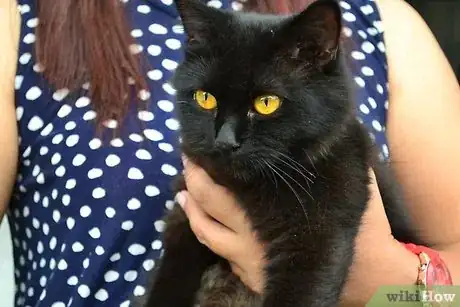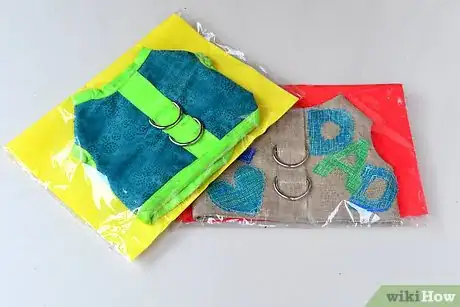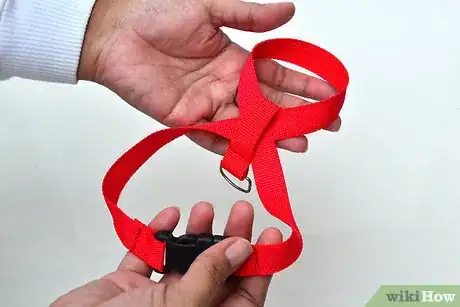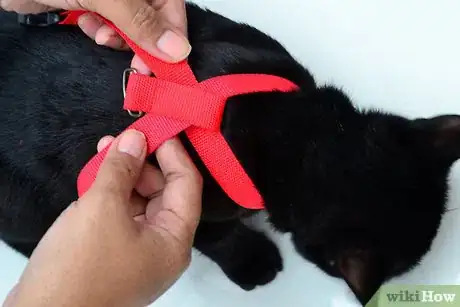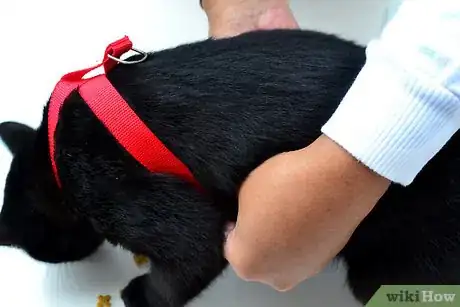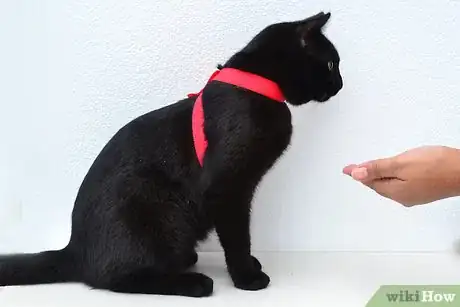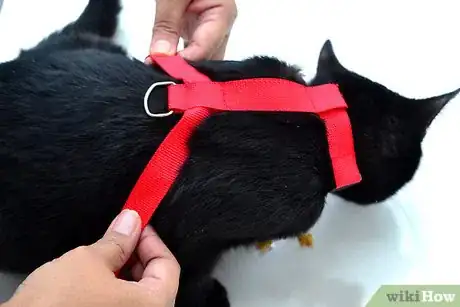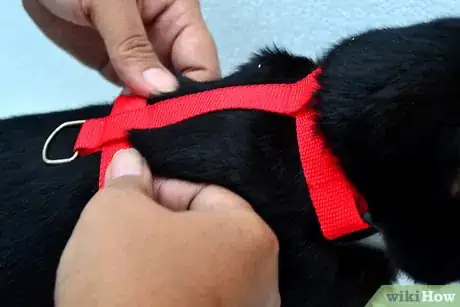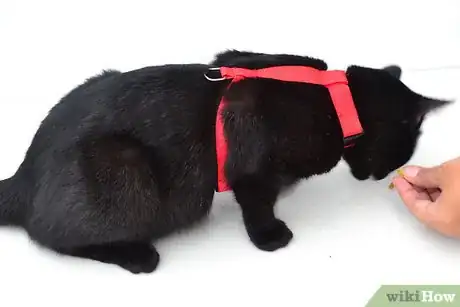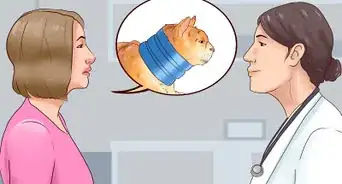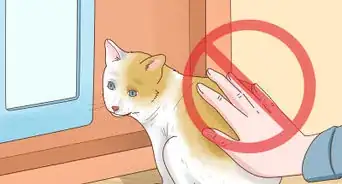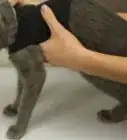This article was co-authored by Molly DeVoss. Molly DeVoss is a Certified Feline Training and Behavior Specialist (CFTBS), a Certified Cat Behavior Consultant (CCBC), a Fear Free Certified Trainer (FFCT), and the Founder of Cat Behavior Solutions. Molly specializes in using positive reinforcement to modify and prevent unwanted behaviors in cats and reduce cat shelter surrender. Molly has sat on the Dallas Animal Advisory committee since 2013 and was voted one of the Top 12 Extraordinary Cat Behaviorists of 2020 by Catpetclub.com. She is certified by both the Animal Behavior Institute and the International Association of Animal Behavior Consultants. She is also the host of the weekly podcast Cat Talk Radio.
This article has been viewed 132,313 times.
Are you considering putting a harness on your cat? Perhaps you want to walk the cat outdoors, or maybe you need to travel with the cat and are scared it might escape. Whatever the reason, a harness is a great option, as a cat will have a much harder time slipping out of a harness than a collar. At first sight a harness might look confusing, but in reality they are very simple to put on once you get the hang of it.
Steps
Buying a Cat Harness
-
1Pick a type of cat harness. The most common types of cat harnesses include the Figure Eight and the H-harness. The main difference between the two is that the Figure Eight features just two loops that meet on top of the cat's shoulders, while the H-harness has a short strap that lies between the shoulder blades with the loops sewn onto either end.
- There is no right answer to which type of harness is best. Some owners report the Figure Eight harness is harder to wriggle out of. Indeed, the fit of the Figure Eight harness is much more snug, which could account for why it seems more secure on some cats.
- Other types of cat harnesses include vest harnesses and jacket harnesses.[1]
-
2Figure out what size harness your cat will need. Harnesses usually come in different sizes, such as small, medium, or large. These sizes are typically based on the measurement around the chest, usually 12, 14, 16, or 18 inches.[2]
- Most harnesses have adjustable loops but they are not designed so that a small harness can fit a big cat. Rather, these are designed for ease of comfort and to get the harness to fit snugly.
- To find your cat's chest size use a tape measure and place it immediately behind the cat's front legs. Measure around their chest in a full circle, taking care that the tape is not twisted. Apply gentle pressure so the tape fits snugly but is not digging into the cat. Take this measurement and add 2 or 3 inches - this figure now gives you the size of harness you should buy.
Advertisement -
3Buy a harness for your cat. Cat harnesses are available at most pet stores and they come in a variety of colors and materials. If you have a specific model in mind, however, it may be easiest to buy the harness online.
- Remember that sizes may vary between brands, so a Large in one brand of harness may not fit the same as a Large in another brand.
Fitting a Figure-Eight Style Cat Harness
-
1Orient yourself with how the figure-eight harness should sit on the cat. Hold the harness by the straight piece of strapping between the two loops. Look at the two loops hanging down from the waist and identify which is the smaller. This smaller loop will slip over the cat's head and does not need to be unbuckled. The larger loop will go around the cat's chest, and needs to be unbuckled.[3]
-
2Place the small loop over the cat's head. The spot where the loop connects to the connecting strap should rest just above of the cat's shoulders. With the small loop over the cat's head, slide the harness so the "waist" of the figure eight lies on its back between the shoulder blades.
-
3Connect the large loop around the cat's midsection. Take the ends of the bigger loop and feed them under the cat's chest. Check for twists and straighten them out so there is nothing to dig into the cat. Then fasten the buckle.
- If the loop is too small to fit around the cat's chest you will need to ease out some extra length by using the sliding adjustment on the harness.
-
4Check the fit of the harness. A comfortable fit of this harness should be snug but allow you to insert two to three fingers between the harness and the cat. Use the sliding adjusters to lengthen or shorten the loops individually until you are satisfied the cat is both comfortable and secure.
-
5Let your cat get used to the harness while indoors.[4] You want the cat to get so used to the harness that it basically forgets that it is wearing a harness. This may be possible for some cats, but not necessarily all cats.
- It may help your cat to accept a new harness if you leave it beside the cat's food bowl before you try putting it on. That way it will come to associate it with good things.
- Gradually increase the time your cat wears the harness until they're fully comfortable with it.[5]
Fitting a H-Style Cat Harness
-
1Orient yourself with how the H-harness fits onto the cat. H-harnesses have a strap that runs along the underside of the cat's chest between the front legs, in addition to the loops and the straight piece that a figure-eight harness has.
- If the loops of your H-harness are attached by two straight pieces on opposite sides of the loop, then you have a harness with a back strap and a chest strap. It is easy to identify the back strap because it is always shorter than the chest strap.[6]
-
2Place the harness on your cat. Find the short strap (back strap) and hold this. Now slip the cat's head through the smaller loop. Unbuckle the large loop and you'll find one half of the loop forms a large D shape with the chest strap. Simply feed the front leg on the same side as the D, through the space within so that leg is enclosed. Feed the remaining long length of strap under the cat's chest and up the other side, and fasten the buckle.
-
3Check the fit of the harness. A good fit on a H-harness means that the harness is snug but loose enough to allow you to insert two to three fingers between the harness and the cat. It is typical, and important, that you spend some time adjusting the fit of a harness the first time you put it on.
- Use the sliding adjusters to change the size of the loops until you are satisfied the harness is fitting correctly.
-
4Let your cat adjust to wearing the harness.[7] You want your cat to get so used to the harness that it forgets it's wearing it. Remember that not all cats will adjust to wearing a harness, so if your cat really puts up a struggle decide whether you have the time and patience for this kind of training.
- To aid your cat's comfort, also let your cat sniff the harness and be around it for awhile before trying it on. This will make the cat more comfortable. Then, immediately give your cat a treat after they sniff.[8]
- Use treats to help your cat warm up to the harness. Offer a treat to your cat when the harness touches their back. Then, continue giving your cat treats as you go through each step of putting the harness on. Once the harness is in place, praise your cat and reward them with another yummy treat.[9]
- If your cat reacts poorly to the harness, go back to the previous step and take it slower.[10]
- Now you are ready to attach the lead to the harness and off you go!
Expert Q&A
-
QuestionHow do you put a harness on a stubborn cat?
 Molly DeVossMolly DeVoss is a Certified Feline Training and Behavior Specialist (CFTBS), a Certified Cat Behavior Consultant (CCBC), a Fear Free Certified Trainer (FFCT), and the Founder of Cat Behavior Solutions. Molly specializes in using positive reinforcement to modify and prevent unwanted behaviors in cats and reduce cat shelter surrender. Molly has sat on the Dallas Animal Advisory committee since 2013 and was voted one of the Top 12 Extraordinary Cat Behaviorists of 2020 by Catpetclub.com. She is certified by both the Animal Behavior Institute and the International Association of Animal Behavior Consultants. She is also the host of the weekly podcast Cat Talk Radio.
Molly DeVossMolly DeVoss is a Certified Feline Training and Behavior Specialist (CFTBS), a Certified Cat Behavior Consultant (CCBC), a Fear Free Certified Trainer (FFCT), and the Founder of Cat Behavior Solutions. Molly specializes in using positive reinforcement to modify and prevent unwanted behaviors in cats and reduce cat shelter surrender. Molly has sat on the Dallas Animal Advisory committee since 2013 and was voted one of the Top 12 Extraordinary Cat Behaviorists of 2020 by Catpetclub.com. She is certified by both the Animal Behavior Institute and the International Association of Animal Behavior Consultants. She is also the host of the weekly podcast Cat Talk Radio.
Certified Feline Training and Behavior Specialist & Certified Cat Behavior Consultant Certified Feline Training and Behavior Specialist & Certified Cat Behavior ConsultantExpert AnswerUse a training strategy called "counter-conditioning"—this is when you pair a scary or uncomfortable experience with something pleasant, like a treat. Let your kitty sniff the harness first, and reward them immediately after. Continue introducing your cat to the harness gradually, giving them treats every step of the way.
Certified Feline Training and Behavior Specialist & Certified Cat Behavior ConsultantExpert AnswerUse a training strategy called "counter-conditioning"—this is when you pair a scary or uncomfortable experience with something pleasant, like a treat. Let your kitty sniff the harness first, and reward them immediately after. Continue introducing your cat to the harness gradually, giving them treats every step of the way.
References
- ↑ Molly DeVoss. Certified Feline Training and Behavior Specialist & Certified Cat Behavior Consultant. Expert Interview. 15 July 2021.
- ↑ https://www.petsafe.net/media/manuals/cwmk-come-with-me-kitty-manual.pdf
- ↑ https://thecatsite.com/c/harness-and-leash-training-for-cats/
- ↑ https://www.petsafe.net/media/manuals/cwmk-come-with-me-kitty-manual.pdf
- ↑ Molly DeVoss. Certified Feline Training and Behavior Specialist & Certified Cat Behavior Consultant. Expert Interview. 15 July 2021.
- ↑ https://thecatsite.com/c/harness-and-leash-training-for-cats/
- ↑ https://www.petsafe.net/media/manuals/cwmk-come-with-me-kitty-manual.pdf
- ↑ Molly DeVoss. Certified Feline Training and Behavior Specialist & Certified Cat Behavior Consultant. Expert Interview. 15 July 2021.
- ↑ Molly DeVoss. Certified Feline Training and Behavior Specialist & Certified Cat Behavior Consultant. Expert Interview. 15 July 2021.
- ↑ Molly DeVoss. Certified Feline Training and Behavior Specialist & Certified Cat Behavior Consultant. Expert Interview. 15 July 2021.
About This Article
To put on a cat harness, start by holding the harness so that the smaller loop is toward the cat’s head and the larger one with the buckle is toward its chest. Next, unbuckle the large loop and slip the small loop over the cat’s head, with the connecting strap resting above its shoulders. Feed the straps of the large loop under the cat’s chest behind it’s legs and fasten the buckle. Finally, adjust the straps so that the harness is snug, but not tight. For tips from our Veterinary reviewer on how to help your cat adjust to the harness, read on!
